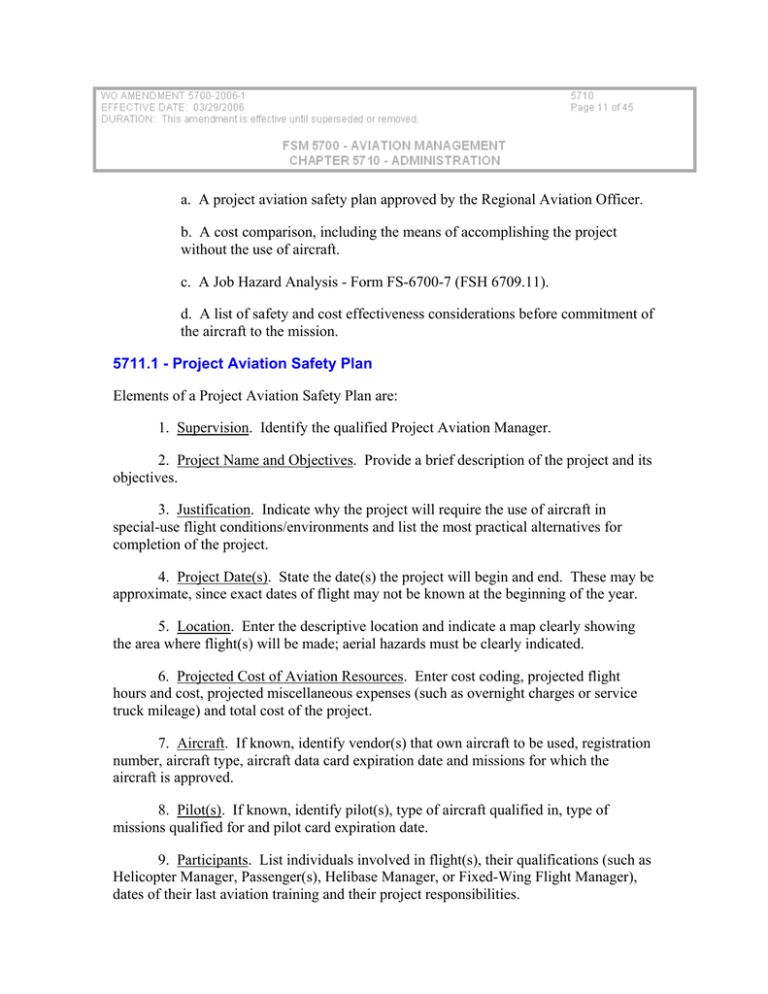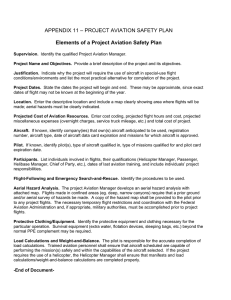a. A project aviation safety plan approved by the... b. A cost comparison, including the means of accomplishing...
advertisement

a. A project aviation safety plan approved by the Regional Aviation Officer. b. A cost comparison, including the means of accomplishing the project without the use of aircraft. c. A Job Hazard Analysis - Form FS-6700-7 (FSH 6709.11). d. A list of safety and cost effectiveness considerations before commitment of the aircraft to the mission. 5711.1 - Project Aviation Safety Plan Elements of a Project Aviation Safety Plan are: 1. Supervision. Identify the qualified Project Aviation Manager. 2. Project Name and Objectives. Provide a brief description of the project and its objectives. 3. Justification. Indicate why the project will require the use of aircraft in special-use flight conditions/environments and list the most practical alternatives for completion of the project. 4. Project Date(s). State the date(s) the project will begin and end. These may be approximate, since exact dates of flight may not be known at the beginning of the year. 5. Location. Enter the descriptive location and indicate a map clearly showing the area where flight(s) will be made; aerial hazards must be clearly indicated. 6. Projected Cost of Aviation Resources. Enter cost coding, projected flight hours and cost, projected miscellaneous expenses (such as overnight charges or service truck mileage) and total cost of the project. 7. Aircraft. If known, identify vendor(s) that own aircraft to be used, registration number, aircraft type, aircraft data card expiration date and missions for which the aircraft is approved. 8. Pilot(s). If known, identify pilot(s), type of aircraft qualified in, type of missions qualified for and pilot card expiration date. 9. Participants. List individuals involved in flight(s), their qualifications (such as Helicopter Manager, Passenger(s), Helibase Manager, or Fixed-Wing Flight Manager), dates of their last aviation training and their project responsibilities. 10. Flight Following and Emergency Search-and-Rescue. Identify the procedures to be used. 11. Aerial Hazard Analysis. Provide an aerial hazard analysis for each flight with an attached map. a. Require a prior ground and/or aerial hazards survey for flights made in confined areas (such as deep, narrow canyons). b. Provide a copy of the hazard map to the pilot prior to any project flights. c. Accomplish necessary planning concerning temporary flight restrictions (TFRs) and coordination with the Federal Aviation Administration and military authorities (if appropriate) prior to project flights. 12. Protective Clothing/Equipment. Identify the protective equipment and clothing necessary for the particular operation and any survival equipment (such as extra water, flotation devices, or sleeping bags) beyond the normal Personal Protective Equipment (PPE) complement that may be required. 13. Load Calculations and Weight-and-Balance. a. Include the Load Calculations provided by the pilot, who is responsible for the accurate completion of load calculations. b. Ensure that trained aviation personnel have determined that the scheduled aircraft are capable of performing the mission(s) safely and within the capabilities of the type of aircraft needed. c. Ensure that manifests and load calculations/weight-and-balance calculations are completed and noted properly by the Helicopter Manager if the project requires the use of a helicopter. 14. Risk/Hazard Assessment. Complete a Risk/Hazard Assessment that identifies hazards associated with the operation and the mitigations and controls put in place to reduce or eliminate them. The process for completing this assessment is found in the Interagency Helicopter Operations Guide (IHOG) and in Chapter 17 of Interagency Standards for Fire and Aviation Operations. 5711.2 - Flight Services and End-Product Contracts Use 5711.2, exhibit 01, to identify whether a project requires a flight services contract or an end-product contract. If the answer is yes in any block, the procurement must be conducted using the flight services process.



